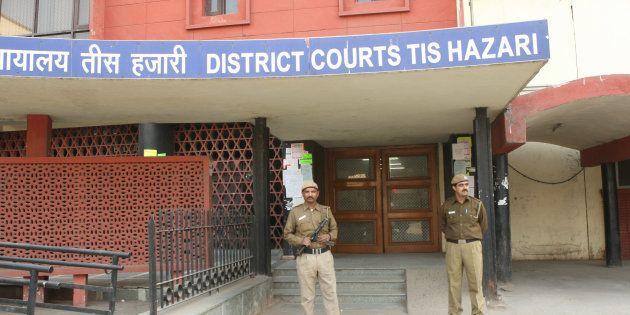Lollipop for Lawyers, Justice for None!

At the Tis Hazari District Court of Delhi, an advocate stood with a placard in one hand and two lollipops in the other, sloganeering, “Vakeelo ko Milla Lollipop” (Lawyers have got lollipops). It was easy to dismiss this as theatricality. I did it for once! The advocate was protesting what he perceived as lip service by the Delhi Police, marking the close of a week-long abstention from work by lawyers. They had been assured that the Lieutenant Governor’s Notification, permitting police depositions through video conferencing from police stations, would be “put on hold”. Even with such assurances, fresh Notifications and Circulars marched on. That was when the lollipops felt less like props and more like a prognosis.
On August 13, 2025, the Lieutenant Governor of Delhi issued a notification directing that all police stations be equipped with video-conferencing facilities for recording testimony. The diktat sought to operationalise the provisions of the Bhartiya Nagarik Suraksha Sanhita (BNSS), witness examination by electronic means.
On September 4, 2025, the Hon’ble Delhi High Court issued a Notification, Electronic Evidence and Video Conferencing Rules, 2025, elaborating the procedure and dovetailing the LG Notification. On the same day, the Office of the Commissioner of Police, Delhi, circulated instructions to all eight Bar Associations of Delhi; formally distinguishing between “formal” police witnesses who could depose from police stations and “material” police witnesses who were to continue appearing physically, subject always to the court’s discretion.
Those in the echelons argued that such measures were necessary to tackle the mountain of pending cases, as the absence of police witnesses and repeated adjournments have clogged the system. It was suggested that these problems can be addressed by remote testimony. But technology ought to be used to strengthen the judicial capacity, not to relocate adjudication into the precincts of the police.
The solution lies in augmenting judicial capacity, better staffing of courts, stricter case management, not in turning the police stations into a surrogate. courtrooms. Efficiency is an administrative virtue, but legitimacy is a constitutional imperative. The two cannot be traded on the same scale.
The arbitrariness here is not a matter of mere form alone; it strikes at the very architecture of the criminal justice system. A courtroom is not simply a concrete structure; it is a carefully curated space that guarantees neutrality and separation of powers. It is where adjudication is insulated from investigation, where witnesses depose under the authority of a judge, and where lawyers test that evidence on equal footing. The courtroom’s symbolism is as important as its function. It embodies the constitutional promise that justice will not be overshadowed by investigative authority. The police station is the mirror opposite. It is a site of investigation, suffused with the authority of the state, hierarchical in structure. To convert it into a routine site of evidence by video-link is to collapse the distinction between investigation and adjudication.
For the accused, such a proceeding risks being reduced to a mere annexure to the police report. For judges, it corrodes institutional legitimacy, for justice must not only be done but also be seen to be done. A deposition from a police station does not resemble adjudication but rather the mechanics of bureaucracy, where judicial authority is perceived as an appendage of investigation.
The lawyers’ strike was more than professional resistance. They are daily witnesses to how fragile the safeguards of due process are, and how easily the rights of the accused and complainants alike are subsumed by institutional convenience.
The protest acquires a sharper meaning when examined in the backdrop of the withdrawn Advocate’s (Amendment) Bill, 2025. The Bill was designed to cull the possibility of collective resistance by branding such abstentions from court work as professional misconduct. Though withdrawn, it does not erase the intent; it rather exposes a deeper anxiety to ensure that future executive measures remain insulated from organised challenge.
This was not a reform but an attempt to condition the bar into a silent spectator of executive action. The resistance is rooted in the recognition that treating the police station as an appropriate site to depose. Once the police station is normalised as a space to depose, which might even expand and ossify into a default.
The irony deepens when the Hon’ble Supreme Court, in a suo motu public interest petition, acknowledged the systemic deficits of India’s police stations: lacking functional CCTVs, and custodial violence remains pervasive. In such a context, to reimagine these very spaces as suitable venues for recording judicial evidence borders on institutional incoherence. If the state cannot ensure even basic surveillance for accountability, how can the same police stations credibly host depositions meant to command public confidence in fairness?
If Delhi is to embrace technology in the criminal justice system, it must be within the constitutional bounds, under the judicial roof, not the police. On September 8, 2025, the Office of the Commissioner of Police issued a Circular stating a modification to its earlier Circular. By virtue of the current Circular, all Police Officers are required to physically appear before the courts, which led to calling off the strike. Seen against the backdrop, the Circular cannot, in law and logic, be mistaken for a modification or alteration of the Lieutenant Governor’s Notification. Until that happens, the chant heard at Tis Hazari will endure, not as a theatre but as an indictment, not merely a satire.
P.S. One of the writers was offered one by the protesting advocate, which was humbly declined.
The writers are legal practitioners based in Delhi. The views are personal.
Get the latest reports & analysis with people's perspective on Protests, movements & deep analytical videos, discussions of the current affairs in your Telegram app. Subscribe to NewsClick's Telegram channel & get Real-Time updates on stories, as they get published on our website.
























